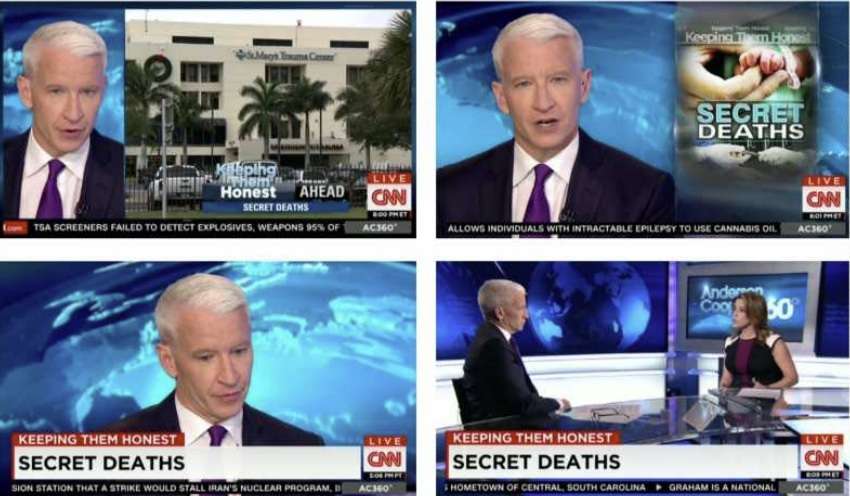
From Black v. CNN, Inc., decided yesterday by Florida Court of Appeal (4th Dist.) Chief Judge Jeffrey Kuntz, joined by Judges Spencer Levine and Alan Forst:
After CNN.com published a story about "surgeries gone wrong" at St. Mary's Hospital, CNN's Anderson Cooper 360°, a television program anchored by Anderson Cooper reported on "secret deaths" at the hospital. Cooper told his audience that these secret deaths stemmed from the surgeon leading the program, Dr. Michael D. Black, failing to conduct the surgeries safely. Cooper even asked why Dr. Black was allowed to continue operating…. Dr. Black filed a defamation lawsuit against the defendants ….
We express no opinion on the merits of Dr. Black's claim. But Dr. Black presented evidence alleging CNN and its employees published a story implying Dr. Black's allegedly deficient performance caused babies to die. The evidence is such that a reasonable jury could return a verdict for Dr. Black….
The factual summary is long, and available in the opinion; but the heart of the dispute had to do with whether CNN falsely portrayed Black as a dangerous doctor based on the raw mortality rate of his operations, which wasn't controlled for their difficulty; here is one of the allegedly libelous statements:
According to the documents CNN obtained from the state, from 2011 to 2013, [St. Mary's] performed 48 open heart surgeries on children and babies. Independently, CNN determined that six infants died, and confirmed the deaths with parents of all six children. From those numbers, CNN was able to calculate the death rate for open heart surgeries as 12.5%, more than three times the national average of 3.3% cited by [STS].
Here's the court's analysis:
[T]he main issue … [in the case] relates to CNN's use of raw morality rate. Dr. Black does not contend that CNN's calculated mortality rate was, in and of itself, "false." Rather, he argues that rate is "meaningless," because a pediatric cardiac surgery program can only be assessed using risk-adjusted data. He asserts CNN and its employees therefore used "meaningless" data to portray Dr. Black as an unsafe doctor who had caused an outsized number of deaths and life-changing complications in his patients.
The value of raw mortality rates as an evaluative tool appears, at best, ambiguous. One expert witness testified in this case that using risk-adjusted data was "desirab[le]," and "[r]aw comparisons of outcomes can be misleading," but raw mortality rates were a "starting point" which could suggest a program had "a problem." Another expert testified that the raw data would not always "fairly reflect the quality of [a] program and [its] operations …." Yet another testified that raw data was not "meaningful" without also considering a surgical program's case mix. And Dr. Jacobs—who told Cohen and Bonifield that raw mortality rates were "essentially meaningless" in their earlier reporting of the Kentucky hospital—testified it was appropriate to rely on raw data in the absence of risk-adjusted data if "contextualized properly and used carefully."
CNN argues that it had asked St. Mary's for the adjusted data and St. Mary's refused to provide it. Dr. Black counters that St. Mary's did provide the requested data in the form of the program's two-star ranking from STS [Society of Thoracic Surgeons], but CNN "just ignored" it. CNN replies St. Mary's merely provided the defendants with the phrase "two-star ranking." But it is possible St. Mary's did not provide the adjusted data because Cohen and Bonifield did not specifically ask for it. In a text to Bonifield, Cohen asked, "I know we never specifically asked for risk adjusted data, but did we ever ask for anything general like for ex[ample] to see their STS report?" Bonifield answered, "No."
In any event, the circuit court held that CNN's use of raw data, rather than risk-adjusted data, was a nonactionable dispute over methodology, citing ONY, Inc. v. Cornerstone Therapeutics, Inc. (2d Cir. 2013). In ONY, the Second Circuit held that "to the extent a speaker or author draws conclusions from non-fraudulent data, based on accurate descriptions of the data and methodology underlying those conclusions, on subjects about which there is legitimate ongoing scientific disagreement, those statements are not grounds for a claim …."
ONY is distinguishable from this case. The Second Circuit's holding applied to statements "presented in publications directed to the relevant scientific community, ideally in peer-reviewed academic journals …." That way, "the validity of the authors' conclusions may be assessed on their face by other members of the relevant discipline or specialty." Reporting published on CNN.com and Anderson Cooper 360° is not directed to the scientific community of pediatric and congenital heart surgeons. And beyond that key distinction, ONY concerned false advertising claims under the Lanham Act, not defamation claims under state law.
Several cases cited by Dr. Black are more persuasive. In one case, the court held that "[a] misrepresentation of the mortality rate for a doctor can be sufficient to support a defamation claim." Topper v. Midwest Div., Inc. (Mo. Ct. App. 2010). There, the court held that the evidence of publication of an incorrect mortality rate could support a doctor's defamation claim.
In another case {Mem'l Hermann Health Sys. v. Gomez (Tex. 2022)}, the Supreme Court of Texas explained why publication of raw (instead of risk-adjusted) mortality rates might support a surgeon's defamation claim:
Patient statistics matter to surgeons and hospitals, who understand what they both do and do not show. A more skilled cardiovascular surgeon may have a higher patient mortality rate than a less skilled surgeon only because of the higher difficulty of surgeries the skilled surgeon takes on. Healthier patients may have better surgical outcomes than those with other health issues.
A flawed data sample that fails to take these and other factors into account can produce skewed results that do not accurately reflect a surgeon's quality of care. Surgeons and hospitals know this. [STS] adjusts the raw data that it compiles for seven risk-adjusted procedures so as not to compare surgical apples and oranges. Due to concerns over sample variations, STS does not create any type of surgeon-specific mortality rate. The resulting database is a highly valuable resource for hospitals that raw data cannot serve.
Based on the summary judgment record, we believe a trial on the merits is required to decide whether CNN's use of a calculated, raw mortality rate to imply babies were dying because of Dr. Black is sufficient to satisfy a defamation claim. We also agree the circuit court erred when it entered summary judgment on Dr. Black's defamation-by-implication claims. Statements that are not false can be defamatory when they create a false impression. Dr. Black's defamation-by-implication claims should proceed to a trial on the merits as well….
Judge Forst concurred; a brief excerpt:
Mark Twain publicized the statement (the source of which is disputed): "There are three kinds of lies: lies, damned lies, and statistics." That quote provides a good description of Appellant Black's case against the defendants—they allegedly published stories (online and via the Anderson Cooper 360° television program), knowingly or with reckless disregard for the truth, defaming Black and his pediatric cardiothoracic surgery program by manipulating statistics to give a misleading description of the program's performance. There is an innate danger in basing conclusory judgments on a small sample size, and genuine issues of material fact remain unresolved at this point in the litigation (notwithstanding the fact that Black's complaint was filed in 2016)….
Thomas A. Clare, Elizabeth M. Locke, Joseph R. Oliveri, and Jered T. Ede (Clare Locke LLP) represent plaintiff.
The post Libels, Damn Libels, and Statistics? Pediatric Surgeon's Lawsuit Against CNN Can Go Forward appeared first on Reason.com.













 Bengali (Bangladesh) ·
Bengali (Bangladesh) ·  English (United States) ·
English (United States) ·